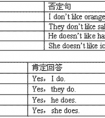How manyon the table?[ ]A. apples, do you B. kiwifruit, are there C. classes, are there-四年级英语
题文
| How many on the table? |
| [ ] |
| A. apples, do you B. kiwifruit, are there C. classes, are there |
答案
| B |
据专家权威分析,试题“How manyon the table?[ ]A. apples, do you B. kiwifruit, a..”主要考查你对 there be 句型,集合名词 等考点的理解。关于这些考点的“档案”如下:
there be 句型集合名词
考点名称:there be 句型
- There be句型:
是英语中常用句型,意思是“有”,表示“人或事物的存在”。
There在此结构中是引导词,已经没有副词“那里”的含义。
There be后面的名词是句子的主语,属倒装结构。常用“There + be+名词+地点/时间状语”的结构。 - There be结构的用法:
A、肯定结构:
There be句型的肯定结构表示“某处存在某物或某人”或“某时发生某事”。
a. There is+单数可数名词/不可数名词+地点/时间状语。
例:There is a cat under the chair. 椅子下面有一只猫。
There is some water in the bottle. 瓶子里有些水。
b. There are +复数名词+地点/时间状语。
例:There are some apples in the basket. 篮子里有一些苹果。
B、否定结构:There be句型的否定结构是在谓语动词be的后面加“not (any)”或“no”.
例:There are no tables in the room. 或者There are not any tables in the room. 房间里没有桌子。
C、疑问结构:There be句型变成疑问式时,要把there和谓语动词be的位置互换。
例:Is there a pen in the schoolbag? 书包里有一支笔吗? - Therebe结构和have的区别与联系:
1.区别点:
there be 意为存在,强调某地有某物,不表示所属关系;
have 表示所有关系, 强调某人或某地有某物,这是其基本用法。如:
There are some trees in front of the house.房前有些树。
Tom has many friends in China.汤姆在中国有许多朋友。
2.相同点:
在表示结构上的含有时,既可以用there be 句型,也可以用have(has) 来表示。如:
中国有许多长河。
There are many long rivers in China.
China has many long rivers.
三月份有多少天?
How many days are there in March?
How many days has March? - There be结构中的be动词的确定:
A、there be 结构中的谓语动词be在人称和数上应与其后的主语保持一致。主语是不可数名词或单数可数名词时用is,是复数时用are。
例:There is a flower in the bottle. 瓶里有一朵花。
There is some money in the purse. 钱包里有些钱。
B、若句子中有几个并列的主语时,be的形式要与离其最近的一个主语在人称和数上保持一致。
例:There is a boy, a girl and two women in the house. 房子里有一个男孩,一个女孩和两个妇女。
There are ten students and a teacher in the office. 办公室里有十个学生和一个教师。
There be结构的句型转换:
A、否定句:
there be的否定式通常在be后加not构成(在口语中be时常与not缩写在一起)。如果句中有some,一般要变成any。 例:
There are some children in the picture.
There aren't any children in the picture.
B、一般疑问句及其答语:
把be提到there前,首字母大写,句末用问号即可。其肯定答语是Yes, there is / are;否定答语为No, there isn't / aren't。 例:
— Are there two cats in the tree?
— Yes, there are. (No, there aren't.)
C、特殊疑问句及其回答
a. 提问句子的主语(包括主语前的修饰语)时,句型一律用“what is+地点介词短语?”(无论主语是单数还是复数都用is)。
例:There are some birds in the tree. → What's in the tree?
b. 就there be后面的地点状语进行提问时,句型用“where is/ are+主语?”
例:There is a car in the street. → Where is the car?
c. 提问可数名词(主语)前的数量时,用how many,句型结构为“how many+ 复数名词+are there+其它)”(主语无论是单数还是复数,be通常要用are)。
例:There are three books on the desk. → How many books are there on the desk?
考点名称:集合名词
- 集合名词:
是语言学上的一个专有名词,意指一种可用来指称一群对象的词语,而这些对象,可以是人、动物、或是一群概念等事物。(family、people)
举例而言,在英语中,“一群狮子”可称为“aprideoflions”,此时“pride”为一个集合名词。 - 集合名词分类及用法特点:
第一类
形式为单数,但意义可以用为单数或复数这类集合名词
包括family(家庭Y: 'Times New Roman'">family(,team(队),class(班),audience(听众)等。
其用法特点为:
若视为整体,表示单数意义;若考虑其个体成员,表示复数意义。
比较并体会:
His family is large. 他的家是个大家庭。
His family are all waiting for him. 他的一家人都在等他。
This class consists of 45 pupils. 这个班由45个学生组成。
This class are reading English now. 这个班的学生在读英语。
第二类
形式为单数,但意义永远为复数这类集合名词
包括cattle(牛,牲畜)cattle(,people(人),police(警察)等。
其用法特点为:
只有单数形式, 但却表示复数意义,用作主语时谓语用复数;不与 a(n) 连用,但可与the连用(连用)。
如:People will laugh at you. 人们会笑你的。
The police are looking for him. 警察在找他。
Many cattle were killed for this. 就因为这个原因宰了不少牲畜。
注:表示牲畜的头数,用单位词 head(单复数同形)。如:five head of cattle 5头牛,fifty (head of ) cattle 50头牛
第三类
形式为复数,意义也为复数这类集合名词
包括goods(货物),clothes(衣服)等。
其用法特点是:
只有复数形式,当然也表示复数意义,用作主语时谓语也用复数),但通常不与数词连用。
如:Clothes dry slowly in the rainy season. 衣服在雨季不易干。
Such clothes are very expensive. 那样的衣服很贵。
If goods are not well made you should complain to the manufacturer. 如果货物质量不好,则理应向制造商提出控诉。
第四类
形式为单数,意义也为单数这类集合名词
包括baggage / luggage(行李), clothing(衣服), furniture(家具), machinery(机器), poetry(诗), scenery(风景), scenery(), jewelry(珠宝), equipment(设备)等。
其用法特点为:
是不可数名词,只用单数形式,不用不定冠词(当然更不能用数词),没有复数形式。
如:Our clothing protects us from [against] the cold. 我们的衣服可以御寒。
Have you checked all your baggage? 你所有的行李都托运了吗?
The thief stole all her jewelry. 小偷把她所有的首饰都偷走了。
The hospital has no decent equipment. 这家医院没有像样的设备。
The Tang Dynasty is thought of as the high summer of Chinese poetry. 人们认为唐朝是中国诗歌的全盛时期。
- 最新内容
- 相关内容
- 网友推荐
- 图文推荐
上一篇:How many books ____ in your desk?[ ]A. is thereB. are thereC. there are -三年级英语
下一篇:Therea lot of sheep over there. [ ]A. isB. areC. haveD. has-五年级英语
零零教育社区:论坛热帖子
| [家长教育] 孩子为什么会和父母感情疏离? (2019-07-14) |
| [教师分享] 给远方姐姐的一封信 (2018-11-07) |
| [教师分享] 伸缩门 (2018-11-07) |
| [教师分享] 回家乡 (2018-11-07) |
| [教师分享] 是风味也是人间 (2018-11-07) |
| [教师分享] 一句格言的启示 (2018-11-07) |
| [教师分享] 无规矩不成方圆 (2018-11-07) |
| [教师分享] 第十届全国教育名家论坛有感(二) (2018-11-07) |
| [教师分享] 贪玩的小狗 (2018-11-07) |
| [教师分享] 未命名文章 (2018-11-07) |




